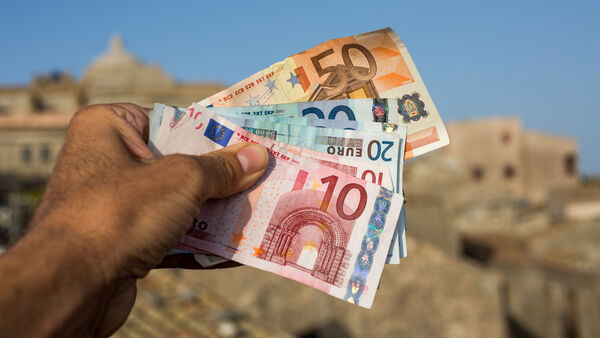Cash and Currency Tips for Europe
By Rick Steves
With the following tips, you'll make the most of every cent you spend.
Resist the urge to buy foreign currency before your trip. Some tourists feel like they must have euros or British pounds in their pockets when they step off the airplane, but they pay the price in bad stateside exchange rates. Wait until you arrive to withdraw money. I've yet to see a European airport that didn't have plenty of ATMs.
Avoid (or at least minimize) cash exchange. Exchanging money is expensive: You'll lose about 5 to 10 percent when converting dollars to euros or another foreign currency. In a pinch, you can find exchange desks at major train stations or airports (convenient, but the hit can be as much as 15 percent).
But exchanging money can make sense in certain situations, including emergencies (if your card — or the only ATM in town — doesn't work), or when crossing into a country that uses a different currency.
If you do need to exchange money, look for places that don't charge a commission. Note the difference between the rates for buying (the bank buys foreign currency from you to exchange into local cash) and selling (the bank sells foreign currency to you). A good rule of thumb: The difference between the buy and sell rates should be less than 10 percent.
European banks generally do not exchange money unless you have an account with them. In some countries the post office runs its own bank that may exchange cash.
Use local cash. Many Americans are thrilled to find a store advertising "We accept dollars." But the happy sales clerk doesn't tell you that your purchase is costing about 20 percent more because of the store's terrible exchange rate. Without knowing it, you're changing money — at a lousy rate — every time you buy something with dollars.
Likewise, in some non-eurozone countries, the euro is commonly accepted, but usually a bad deal. For example, in Switzerland — which officially uses Swiss francs — some ATMs give euros, prices in touristy areas are listed in both currencies, and travelers can get by with credit cards and euro cash. But if you pay in euros, you'll get a rotten exchange rate. Ideally, if you're in a non-euro country for more than a few hours, head to the ATM and use local currency instead.
Use your credit card to get cash only in emergencies. If you lose your debit card, you can use your credit card at an ATM to get a cash advance — but you need to know your PIN, and you'll pay a sizeable cash-advance fee.
Don't stress over currency conversions. Local currencies are all logical. Each system is decimalized just like ours. There are a hundred "little ones" (cents, pence, groszy, stotinki) in every "big one" (euro, pound, złoty, lev). Examine the coins in your pocket soon after you arrive, and in two minutes you'll be comfortable with the nickels, dimes, and quarters of each new currency.
It’s important to know approximate exchange rates. The mathematically challenged can do real-time conversion with an app, but I've never bothered. I see no need to have it figured to the third decimal.
Very roughly determine what the unit of currency (euros, kroner, Swiss francs, or whatever) is worth in American dollars. For example, let's say the exchange rate is €1 = $1.10. If a strudel costs €5, then it costs five times $1.10, or $5.50. Ten euros, at this rate, would be about $11, and €250 = $275 (figure 250 plus about 10 percent more).
Make a game out of quizzing yourself or your travel partner, and soon it'll be second nature. Survival on a budget is easier when you're comfortable with the local currency.
Assume you'll be shortchanged. In banks, restaurants, at ticket booths, everywhere — expect to be shortchanged if you don't do your own figuring. Some people who spend their lives sitting in booths for eight hours a day taking money from strangers have no problem stealing from clueless tourists who don't know the local currency. For 10 minutes I observed a man in the Rome subway shortchanging half of the tourists who went through his turnstile. Half of his victims caught him and got their correct change with apologies. Overall, about 25 percent didn't notice and probably went home saying, "Mamma mia, Italy is really expensive."
Plan your cash withdrawals wisely. Avoid having a lot of unused currency left over when you cross borders between countries that use different currencies. But you'll also want to avoid unnecessary frequent ATM visits, to minimize withdrawal fees.)
Spend your coins before leaving a currency zone. Since big-value coins are common in Europe, exporting a pocketful of change can be an expensive mistake. Spend them (on knickknacks or snacks), change them into bills, or give them away before you head into a country where they're worthless. Otherwise, you've just bought a bunch of round, flat souvenirs. Note, however, that while euro coins each have a national side (indicating where they were minted), they are perfectly good in any country that uses the euro currency.
Multicurrency accounts make sense only for frequent travelers. Some banks offer multicurrency accounts, which allow you to transfer, receive, and hold several different currencies in the same bank account. These can be helpful for people who spend extended periods of time abroad (since transactions aren't subject to unpredictable exchange rates). But if your European travels are limited to the occasional vacation, multicurrency accounts are likely overkill; it's easier to stick with a fee-free credit card.


